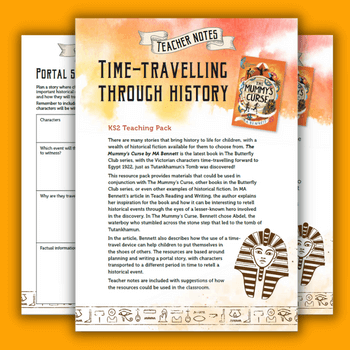Ancient Egyptians KS2 – Take your class on a time-travelling adventure!

One of the greatest archaeological discoveries of all time was made by a young boy – a fact that’s sure to make the Ancient Egyptians irresistible to your class, says MA Bennett

- by MA Bennett

All the Butterfly Club books hinge on a theorem called The Butterfly Effect, a concept that, essentially, states that the mere flap of a butterfly’s wings in one place can have a huge impact in another far away.
Each book features time-travelling thieves Luna, Konstantin and Aidan who travel forward in time from Greenwich, London, in 1894. They steal artefacts from the future on behalf of a shadowy secret society called The Butterfly Club.
The Butterfly Club books are about the ultimate kind of travel – time travel.
And because time travellers always – funnily enough – seem to wind up in the most interesting periods in history, the urge to have them meet real historical figures is irresistible.
But I did manage to resist the temptation to have my three young heroes meet Shakespeare or Caesar or Columbus.
Instead, the series takes as its subject very well-known events, but largely unknown heroes.
Ancient Egyptians heroes
Most everyone has heard of the Titanic. But, Guglielmo Marconi, whose wireless radio saved hundreds of lives on that doomed ship and countless lives over the following century, is unknown to many.
Similarly, most kids will have heard of the Mona Lisa. But, lots of them won’t know that the painting wasn’t famous at all until it was stolen! In 1911, a man named Vincenzo Peruggia, thought that her smile could save his home country of Italy from defeat in the impending Great War. So he stole it.
And the moon landings of 1969 are familiar to the majority of people. However, many space fans won’t realise how close the Apollo 11 came to a fatal explosion on the moon’s surface! It was only averted by the brave men and women of Mission Control.
Each story in The Butterfly Club series focuses on one extraordinary real-life character from the past. And every one, in a small way, changed history. And The Mummy’s Curse is no different.
So, there’s an awful lot of information already out there about the Ancient Egyptians. You might ask why did I decide to focus on this particular historical moment?
Well, the real hook for me was part of the Tutankhamun story. Specifically, that the first discovery of the tomb was actually by a 12-year-old waterboy – Hussein Abdel Rassoul.
Abdel’s mule stumbled on a long stone in the Valley of the Kings. This turned out to be the top step of twelve, leading down into the most incredible treasure chamber ever found.
Howard Carter himself recognised Abdel’s contribution to the find. He awarded him with a priceless pectoral pendant from the tomb, made of gold and decorated with lapis scarabs as big as your fist.
I thought Abdel would be such a good conduit into the story for a Middle Grade reader. A boy just their age made the greatest archaeological discovery of all time!
Tomb of Tutankhamun
It’s an amazing story that has captured interest ever since. We can see the impact of the discovery of the tomb of Tutankhamun throughout different eras.
There was a huge interest in Egyptology in Victorian times. You can see reflected in art and architecture, and even English tomb design.
There were extraordinary public displays of ‘unwrapping’ of real mummies, too. Even a type of paint called ‘mummy brown’ was popular with the Pre-Raphaelites. It was actually made of crushed up mummies!
So it’s no wonder, when people took such liberties with what were essentially people’s corpses, that there were those who thought the manifold Egyptian gods would get angry…
And there’s quite a weight of evidence for the curse of Tutankhamun. It began to gather traction when the British newspapers started to connect several tragic events to the opening of the tomb in 1922.
Trending
As well as Lord Carnarvon (who provided the financial backing for the excavation), American railroad magnate Jay Gould died of pneumonia after visiting the tomb.
French Egyptologist Georges Bénédite had a bad fall on the steps of the tomb and died. Arthur Mace, one of Carter’s own excavation team, had an entire physical breakdown which led to his death.
Sir Archibald Reid, a radiologist who x-rayed some of Tut’s artefacts, also died. Richard Bethell, Lord Carnarvon’s secretary, committed suicide.
Bethell’s father, Lord Westbury, on hearing the news, cried, “It’s the curse of the Mummy!” and threw himself out of a window.
In 1924, British Army major Sir Lee Stack was murdered in Cairo. An Egyptian prince called Ali Fahmy Bey was shot by his wife in the Savoy Hotel, also after visiting the tomb.
Little wonder then that even 100 years later those ideas still prevail with films like The Mummy and MCU shows like Moon Knight.
It’s irresistible, isn’t it, the idea that Tutankhamun would curse those who disturbed him? It’s just something that seems to seize the imagination in any age. Perhaps that’s the reason the Egyptian civilisation seems to hold such a fascination for schoolkids.
WW1 KS2
Because of that, I took the opportunity in my own Ancient Egyptian adventure to get children to think about bigger themes. For instance, my character Konstantin is German-born, and in 1894 where he lives, everyone is friends.
But in The Mummy’s Curse, he is transported to 1922, just after the terrible First World War. Among the English in Egypt, there is a lot of anti-German feeling.
Similarly, Lady Evelyn Herbert, Lord Carnarvon’s daughter, has quite progressive ideas about women, who have just been given the vote. To the children from 1894, that idea is inconceivable.
So, the time travel device is a good one to put ourselves in the shoes of others, and also to bring little known figures to light.
Sometimes history can feel a bit dry, so if it’s wrapped in a riddle and rolled in a mystery, I think it’s easier to get children to engage.
I call this ‘stealth learning’. Kids are very smart and know exactly when you’re preaching to them.
And if they sense the preaching, they can easily switch off. But I hope that by combining history with adventure, I’ve managed to sneak in some quite complicated ideas, such as the rights and wrongs of Empire, and the restitution of artefacts to their native countries.
And of course, my main objective in writing The Butterfly Club series was to bring unknown characters out of the shadows – like Abdel Rassoul – and into the light.
Hopefully by reading these books more and more children will become aware of extraordinary lives like his.
MA Bennett is the author of The Butterfly Club series. The Mummy’s Curse (£7.99, Welbeck) is on sale now.










